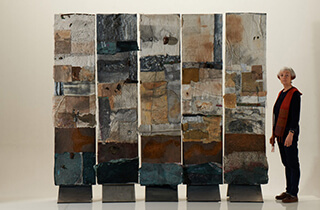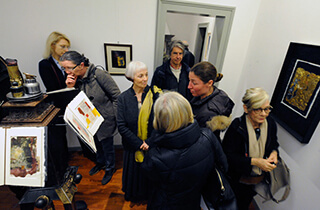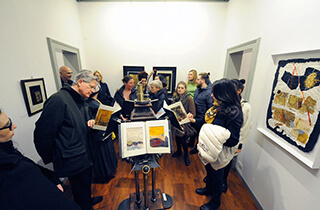Arte in Bergamo • 2015
c/o Il Filandone
Via Allegreni, 37 – Martinengo (Bg)
La carta Hanji custode della storia • 2015
Consolato Generale della Repubblica di Corea
Piazza Cavour, 3 - Milano
Liberbook • 2015
2° Salone del libro d'artista e della stampa d'autore
Voltoni del guazzatoio, Palazzo della Pilotta, Parma.
Un Viaggio singolare • 2015
Galleria Ceribelli - Via S. Tomaso, 86 -
24121 Bergamo
WEB: www.galleriaceribelli.com
 2014
2014
Salon d'Editeurs de Livres de Bibliophilie Contemporaine
Espace Charenton 327 Rue De Charenton 75012, Paris
Artelibro • 2013
Festival del libro d'Arte
Palazzo Re Enzo e del Podestà, Bologna
L’oggetto esposto si presenta come una forma composita. Il reggilibro, intagliato in legno di frassino, è sorretto da esili cilindri che a loro volta si inseriscono in semisfere fresate per contenere, nei canali circolari le varietà degli inchiostri. Il tutto regge l’elemento tematico: libri d’artista. Uno di questi si presenta come un piccolo volume corredato con scritti e con carte che ne visualizzano i contenuti.
Le placchette in rame che emergono dalle pagine, sono chiose per memorizzare la lettura e segnare i fogli. Il secondo libro si sviluppa in un unico foglio, ripiegato con struttura a soffietto, sul quale sono impressi segni che alludono ad emblemi per ex libris. A lato del reggilibri sono assemblati elementi che in modo difforme dalle usuali proporzioni sono riconducibili agli strumenti della stampa e della rilegatoria. L’ampia forma con manico in pelle e blocca mano in rame ha la funzione di taglia risme di carte. Nel contempo è intesa come base portante per altri strumenti di lavoro come gli aghi per cucire i fogli, i punzoni, i separatori di pagine, i fili. Le proporzioni sono volutamente alterate per meglio visualizzare le specifiche funzioni.
Liberbook • 2013
First exhibition of Art books and authorial print
Voltoni del guazzatoio, Palazzo della Pilotta, Parma.
Handmade paper with the intent to suggest, as a starting point of the chosen haiku, the foam of the sea, the wings of butterflies, the sky lit up by the moon. Sheets are placed on the table as on stems of a flower, they can be moved onto the twisted stem at the whim of the moment; they are moments and feelings captured after reading loads of texts that refer to the charm and poetic evocations of nature.
Art book • 2011
Art book Festival
Palazzo Re Enzo e del Podestà, Bologna
The exposed object is presented as a composite form. The book holder, carved in wood ash, is supported by slender cylinders, which in turn are part of milled half spheres to contain, in circular ducts, the varieties of inks. The whole holds the thematic element: art books. One of these looks like a small volume accompanied with writings and cards that display its contents. The copper plates that emerge from the pages have annotations to memorise the reading and mark the sheets.
The second book is developed in a single sheet, bellows folded structure, on which are engraved signs that allude to emblems for bookplates. To the side of the bookends are assembled elements that in a different manner from the usual proportions are attributable to the instruments of printing and bookbinding. The wide shape with leather handle and copper locks hand, has the function of cutting reams of papers. At the same time it is intended as a support system for other work tools such as the needles for sewing the sheets, the punches, the page separators, the wires. The proportions are intentionally altered to better visualize the specific functions.










































































































